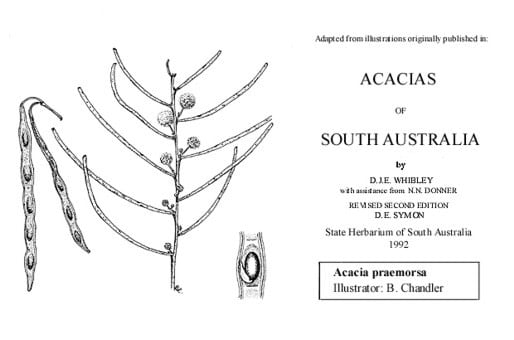Acacia praemorsa P.Lang & Maslin
WATTLE
Acacias of Australia
Family
Fabaceae
Distribution
Extremely localised on the Eyre Peninsula, S.A.
Description
Glabrous shrub 1–3 m high, often suckering. Branchlets angled at extremities. Phyllodes linear, ±incurved, 2–9 cm long, 1–2.5 mm wide, obliquely truncate at apex, flat but thick, smooth but finely longitudinally rugulose when dry; midrib absent or scarcely evident superficially; glands 2, with apical gland brown and adjacent to blunt mucro, and basal gland inconspicuous and 6–18 mm above indistinct pulvinus. Inflorescences mostly 1-headed racemes; raceme axes 1.5–3.5 mm long, often growing out; peduncles 6–12 mm long; heads globular, 34–58-flowered, bright golden. Flowers 5-merous; sepals free. Pods linear, to 13.5 cm long, 5–8.5 mm wide, crustaceous to ±cartilaginous. Seeds longitudinal, elliptic-lenticular, 4.5–6.5 mm long, punctulate, subnitid, dark brown; aril 2/5–3/5 length of seed.
Habitat
Grows in loam on lower slopes and at base of steep gullies, in the zone of contact between dense open heath and open tall shrubland or open scrub.
Specimens
S.A.: Hundred of Mann, T.Croft 24b (AD, CANB) and P.J.Lang D8722 (AD, PERTH).
Notes
Most closely related to A. microcarpa and its allies but distinguished by its linear, superficially nerveless phyllodes (which are 2–9 cm long and 1–2.5 mm wide), 34–58-flowered heads and punctulate seeds. In habit and foliage, A. praemorsa bears a striking resemblance to Senna artemisioides subsp. petiolaris.
FOA Reference
Data derived from Flora of Australia Volumes 11A (2001), 11B (2001) and 12 (1998), products of ABRS, ©Commonwealth of Australia
Author
B.R.Maslin
This identification key and fact sheets are available as a mobile application:
URL: https://apps.lucidcentral.org/wattle/
© Copyright 2018. All rights reserved.








